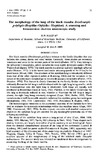| dc.description.abstract | The black mamba (Dendroaspis polylepis) belongs to the family Elapidae that also
includes the cobras, kraits and coral snakes. Generally, these snakes are extremely
venomous and occur in the warmer parts of the world (Parker, 1977). They belong to
the infraorder Caenophidia, which includes the most highly developed snakes (Webb,
Wallwork & Elgood, 1978). The black mamba is a diurnal and only sparingly arboreal
snake (Skinner, 1973). It is the fastest land snake, attaining speeds of 16-19 km/hr for
short bursts (Wood, 1980). The structure of the ophidian lung is remarkably different
from that of the other reptiles (Luchtel & Kardong, 1981) and the variation in the
nature of the pulmonary morphology in this reptile group is remarkable (Porter, 1972;
Duncker, 1978). This feature is clearly illustrated in the family Boidae where in the
subfamily Boinae the left lung is well developed with the right lung being smaller, while
in Tropidophinae only the right lung is developed; both lungs are equally well
developed in Bolyeriinae (Goin & Goin, 1962). Further, in the family Colubridae the
left lung is drastically reduced in size, whereas in Viperidae the left lung is largely
absent, the right lung being extremely elongated (Cope, 1894; Butler, 1895). These
variations show well the notable adaptive radiation this reptilian group has undergone
(Brongersma, 1949, 1951; Underwood, 1967, 1976; Pohunkova & Hughes, 1985).
The morphological variations in the pulmonary anatomy of the Ophidia have been
used to evaluate the systematic relationships within this reptilian taxon (Cope, 1894,
1900; Underwood, 1967, 1976). In this respect, extensive and detailed comparative
studies on the ophidian lungs are essential for any meaningful systematic use of this
differing morphology.
The study of the ophidian lung covers a long period of time (Cope, 1894, 1900;
Butler, 1895; Marcus, 1937; Varde, 1951; George & Shah, 1956). These elegant early
studies, however, are largely descriptive of gross anatomy or are histological. Apart
from the detailed ultrastructural account of the lung of the rattlesnake (Luchtel &
Kardong, 1981) and the garter snake (Pohunkova & Hughes, 1985), apparently only
brief accounts of the ultrastructure of the snake lung are available (Okada et al. 1962;
Nagaishi, Okada, Ishika & Daido, 1964; Brooks, 1970). Stinner (1982) gave an
excellent account of the morphometry of lung of the colubrid snake Pituophis
melanoleucus. The present study was intended to supplement these investigations by
examining the lung of the black mamba. | en |

